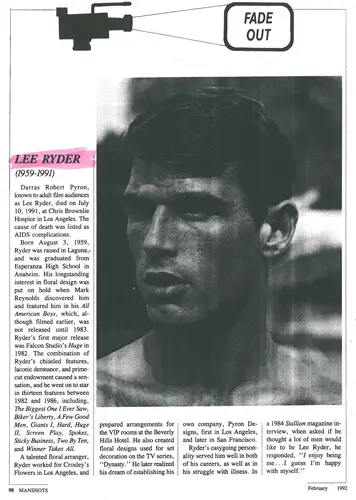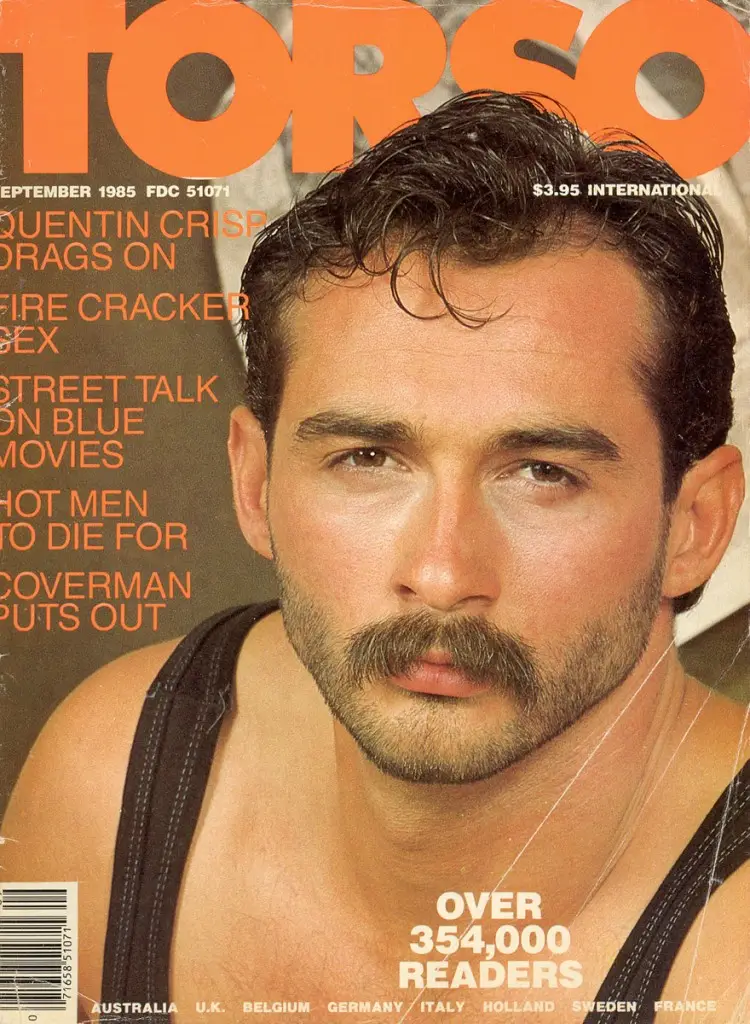
We at Bijou carry back issues of Manshots magazines, which was, I think, in its heyday (the late eighties and early nineties), offered a sophisticated approach to gay porn; its video reviews were generally cogent and intelligent, even scholarly. It treated gay porn in all its variety of genres like something that deserved thoughtful analysis, especially the movies now legendary directors like Steve Scott, Toby Ross, and Tom DeSimone made (movies Bijou carries, by the way).
And Manshots also offered some telling biographies of and interviews with most of the great gay porn stars of the past; again, treating their lives (and of course their activities on screen) as something as interesting and entertaining as any feature on a celebrity in a mainstream magazine like People.
And if there was a gay porn star, or “retrostud” who deserved celebrity treatment, it was Lee Ryder. But like many of the gay porn stars of that period, as noted in the alltoocommon “Fade Out” feature at the back of so many back issues of Manshots, he died of AIDS-related complications (in 1991).
Lee Ryder was born in 1959 as Darras Robert Pyron. He was California born and bred, raised in Laguna, and he graduated from Esperanza High School in Anaheim.
After Mark Reynolds discovered him and featured him in All American Boys, he literally made a splash in Falcon Studio's Huge in 1982.
He starred in thirteen features between 1982 and 1986, including Bijou titles Screenplay, A Few Good Men, Giants 1, and 2 X 10.
Now, of course, if one views these films, it's clear that Lee Ryder's cock is pretty much legendary. According to one Jeff Starkey, who reviewed the movie Screenplay in tandem with Ryder's appearances at the Bijou Theater to greet fans and sign autographs back in 1984:
"Ryder's cock is long, thick, and shapely and is crisscrossed by just the right number of lovely veins. Beneath it hang a perfectly balanced pair of what appear to be 5pound balls. When his cock appears in public, it is usually hard as a baseball bat, with its swollen head looking purple and petulant."
Purple and petulant? Wow. Perhaps those adjectives could apply to the cock, but not the person.
 In an interview with Stallion magazine, known for his sexually aggressive but also unforced, natural screen presence, seems rather lowkey, both veering between a quiet confidence in himself, but also showing a somewhat self-deprecating attitude. Definitely not the “divo” attitude of so many celebrities: “Everyone wants to look at me, I am the Adonis with the giant cock and all should worship me."
In an interview with Stallion magazine, known for his sexually aggressive but also unforced, natural screen presence, seems rather lowkey, both veering between a quiet confidence in himself, but also showing a somewhat self-deprecating attitude. Definitely not the “divo” attitude of so many celebrities: “Everyone wants to look at me, I am the Adonis with the giant cock and all should worship me."
In fact, in the interview, he actually seems rather pragmatic: he does it for the money, and for his business (he actually was a successful floral designer), but ... he actually doesn't see himself as a sex symbol. He just enjoys being himself, and letting a chink of vulnerability come out, being wanted.
(We also find out in the interview he had a relationship with an older guy from ages 15 to 18, who tragically committed suicide soon after they broke up.)
To add to the complexity of his character, despite his appearance at the Bijou and other venues as a gay porn celebrity, he actually admits he would rather not be recognized (he even goes to Europe to escape the attention)... and he notices, even when he does, the guys stay away, or “they stare – I guess I do show a big crotch – or they look at my eyes.”
To be honest, at least for me, the eyes can be just as erotic as, especially in Ryder's case, a dick of death. And Ryder he admits in the interview that he loves his eyes. And rightly so!
His eyes make love to the camera, like those of that famous movie star Joan Crawford (completely the opposite in her approach to celebrity). The eyes themselves create a unique effect in the viewer; they seem to draw you in with a promise of something intense; you think he is looking directly at you via the camera, which could satisfy your desire, but you at the same time feel like you will always want more. Perhaps it's their narrow shape but also richly colored pupils. I don't know, but I can't stop looking at his picture on the cover on Stallion magazine as I write this piece.
And I promise you, you won't be able to take your eyes off of Lee Ryder in our remastering of Huge (now Huge 1) as he beats his meat while perched on the toilet making it bigger, hotter and harder. He, Rick Jensen and Matt Stoker roll around on the cold concrete floor, licking each other's hairy armpits and sitting on each other's faces.






 In the spring of 1975, states were repealing sodomy laws, though on April 12 the Arizona House passed an emergency measure to ban same-sex marriages, and the Colorado Attorney General ruled such marriages were illegal too.
In the spring of 1975, states were repealing sodomy laws, though on April 12 the Arizona House passed an emergency measure to ban same-sex marriages, and the Colorado Attorney General ruled such marriages were illegal too. On May 19, Jack Stillman made his debut as Jack Wrangler when he performed a striptease on cowboy gear at the Paris Theater in Los Angeles. He was dressed like a cowboy. He took his surname from those cowboy jeans that really show off a cute ass, of course.
On May 19, Jack Stillman made his debut as Jack Wrangler when he performed a striptease on cowboy gear at the Paris Theater in Los Angeles. He was dressed like a cowboy. He took his surname from those cowboy jeans that really show off a cute ass, of course.


 In fact, I can't think of a specifically gay cabaret in Chicago since the closing of Gentry (it tried to revive itself in Boystown after leaving the Rush Street area, but it has since closed). There's a place called Davenports in the hipster area Wicker Park which is a piano bar not specifically gay (I noticed on its schedule
In fact, I can't think of a specifically gay cabaret in Chicago since the closing of Gentry (it tried to revive itself in Boystown after leaving the Rush Street area, but it has since closed). There's a place called Davenports in the hipster area Wicker Park which is a piano bar not specifically gay (I noticed on its schedule 

 “Pierce is quite stunning and every time I look at him I do get a bit weak. Looking at his photos that night I began to want to see him naked immediately.” – randyblue.com
“Pierce is quite stunning and every time I look at him I do get a bit weak. Looking at his photos that night I began to want to see him naked immediately.” – randyblue.com